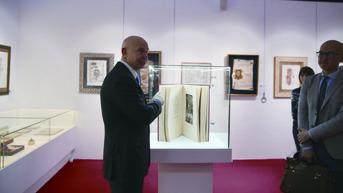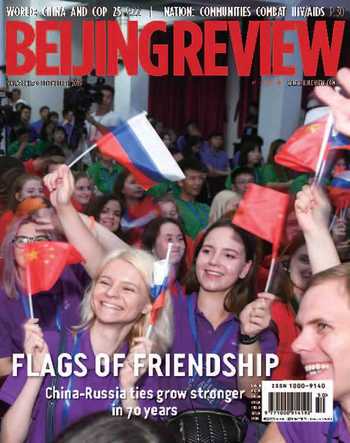THE ART OF COMMUNICATION
2019-09-10ByWangHairong
By Wang Hairong

As its name suggests, the Sokolniki Culture and Recreation Park in Moscow is more than just an outdoor retreat. It also offers an opportunity for cultural enrichment. Deep in this large expanse of dense woodland stand several rows of buildings, one of which, a twostory structure with orange trimming, is the Contemporary Museum of Calligraphy.
Officially opened to the public in August 2008, the museum houses more than 200 art pieces including Arabic, Chinese, European, Indian, Japanese and Slavic calligraphic works.
“One of the most interesting items in the museum is a book of calligraphic work on the 36 military tactics applied during wars in ancient China,” Alexey Shaburov, founder and curator of the museum, told a group of reporters from the China International Publishing Group (CIPG) on November 24.
The giant book is displayed in a large glass case. Shaburov took it out and thumbed through its pages to show some of its content. Each stratagem, usually expressed in four Chinese characters, is written on one page and accompanied by a Russian translation on another page. The stratagems embody the wisdom of Chinese people, and are not only useful on the battlefield, but also for business and personal life, according to Shaburov.
He said he became fascinated with calligraphy as a way to bring his thoughts to life with beauty and power. After reading an inflight magazine article about museums, he decided to establish one in Moscow to bring calligraphy to the city.
Many Chinese works in the museum were donations from various calligraphy and painting associations in China, he said. The first one was donated in 2008 by Ye Bo, a professor at the Beijing Institute of Graphic Communication.
The museum has played an important role in promoting calligraphy in Russia. “Calligraphy wasn’t seen as an art form in Russia. But this year, some of the artworks from our museum, including those of Chinese origin, were made a part of the non-public section of the Russian museum collection,” Shaburov said, adding that this means that calligraphic works are acknowledged as cultural heritage and will be protected in Russia.
In addition to being a treasure trove of art, the museum serves as a cultural and educational center where excursions and workshops are held and calligraphy and lettering courses are offered to children and adults.
This year marks the 70th anniversary of the establishment of diplomatic ties between China and Russia, leading to a flurry of celebration activities at the museum.
An exhibition titled the Great Chinese Calligraphy and Painting was held in September, something Shaburov was clearly proud of. The three-day event displayed about 450 pieces of calligraphic work and paintings and attracted approximately 30,000 visitors, he said.
At the opening ceremony of the exhibition, Ivan Melnikov, First Deputy Chairman of the State Duma, the lower house of the Russian parliament, and Chairman of the Russia-China Friendship Association, said cultural and peopleto-people exchanges are important pillars of Russia-China cooperation.
Shaburov has visited China many times. In January, he visited CIPG in Beijing, introducing his museum and proposing co-organizing activities for the promotion of Chinese brush calligraphy. He also attended a meeting of the China Hard Pen Calligraphy Association in Beijing as a guest of honor.
“I’m proud to contribute to the preservation of the beauty and richness of the writing traditions of different nations for future generations,” Shaburov said.
